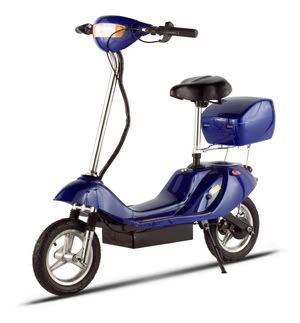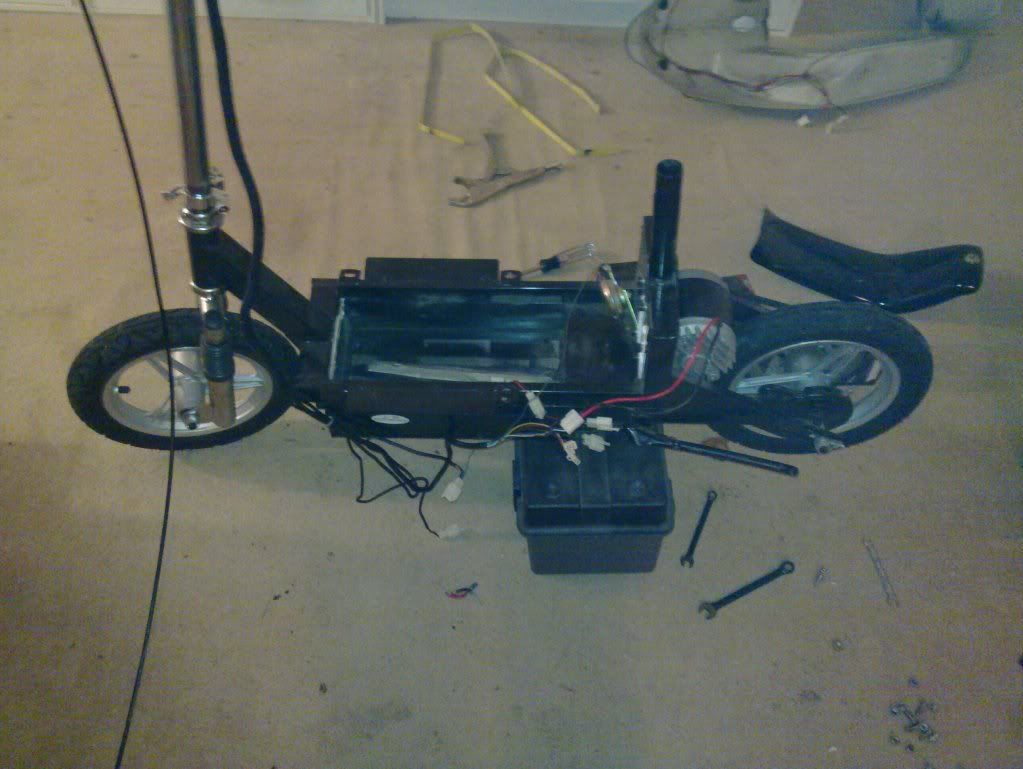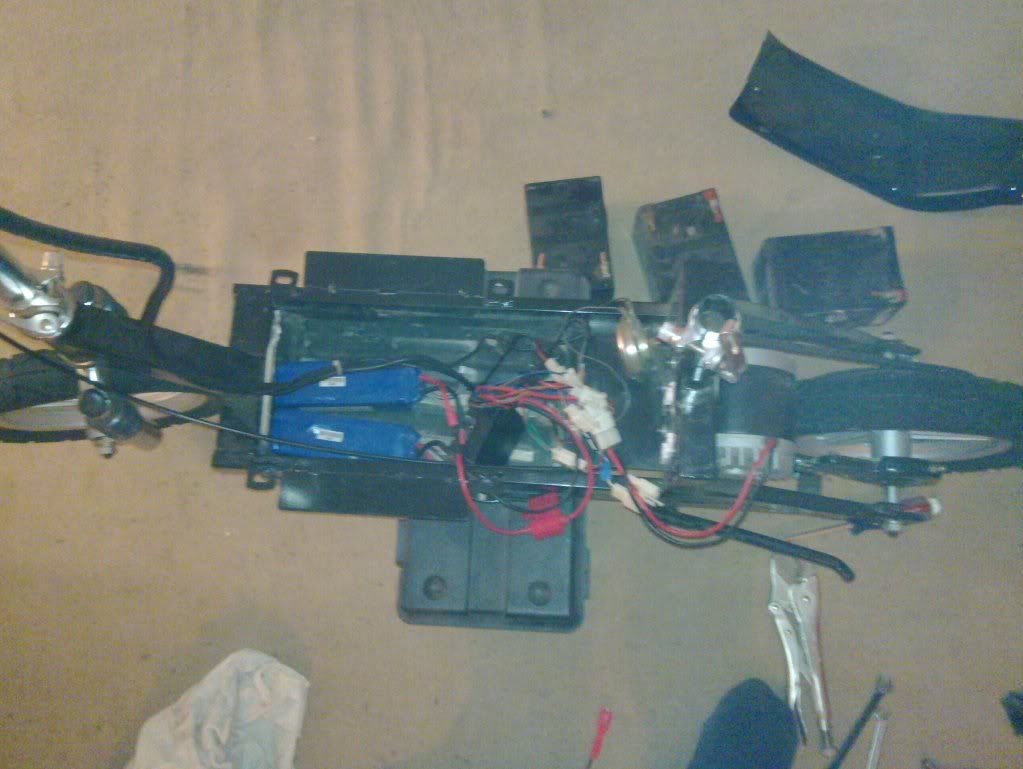I promised I would put these projects up here, so here we go.
As I mentioned in another thread, I've been away from the boards for a while partly because of my new job (well, not so new anymore...been there almost 5 months now) but also because my interests have been shifting. I've become quite interested in EV tech and EVs recently, and in the near future will be starting on (and finishing...I promise..) a few different EV projects of various types. I figure there may be some on here that might be interested in that
so I'll be posting build-logs of all these projects on here.
So, on to the first one.
Quite a while ago, back in late 2010 when I first started getting into this stuff, I picked up a couple cheap Chinese electric scooters with dead batteries. I could have sworn I had a picture of the two of them, but it looks like I don't...and it's cold outside, so I don't feel like going out there and getting a new picture.. So here's a picture from the company's website instead.
They're made by a company called 'X-Treme Scooters'; their "X-360" model. Now, I'll say right now, I would never pay the $350 pricetag they were asking for these things last I looked. At $50/each though, yeah, sure, I'll see what I can do with them.
Now, for technical bits.
These scooters were originally fitted out with three 12V 10Ah SLA batteries, a brushed DC motor that they rate at 360W, and a 36V 20A brushed DC motor controller.
The batteries, of course, had to go. Them being dead aside, SLA is just a waste of space and weight in my opinion. So, those came out:
....actually had some bulging on those...I need to get them out of my house...
Now, in the process of pulling those out I had to take the cheap, plastic cover off. I had been planning on doing this anyway because it looks like **** imo, but this gave me an excuse.
And here we go with that:
I have to say, I have been quite impressed with the quality of both the physical and electrical components. Once I got past the flimsy plastic cover, it's actually quite solidly built and the components actually are pretty decent as well.
I took it out for a quick spin the other night after stripping it down, just dropping a 48V li-po battery pack I had lying around from another project, and it was quite fun.
Definitely felt that controller though... The motor has a lot more to give, as I expected...runs just fine if I hook up the battery pack directly...That controller needs to go though. I'm tripping both the 36V and 20A limits, and if I give it too much throttle it just shuts off, so that needs some help.
...and this brings me to a motor rant...feel free to skip unless you feel like hearing me rant about technical details of electric motors.
[RANT]
This is not actually my first attempt at a small EV. I tried to get a rear hub-motor-powered ebike working back in early 2010; bought the motor, controller, throttle, and batteries, and worked at getting it all put together. ....and so we come to my issue...position sensors...
...ok, take a step back, wtf am I talking about..
There are three basic types of electric motors:
1) Brushed DC (BDC)
2) Brushless permanent magnet DC (BLDC)
3) AC Induction
1) Most of the small motors you see in consumer products are brushed DC motors. Basically, they have coils or loops of copper in the armature (the part around the rotor that spins) that have current passed through them by way of graphite brushes in order to generate the armature's magnetic field. Sometimes the stator (stationary part around the edge of the motor) is a permanent magnet, sometimes it is electromagnetic coils, but either way the armature is always powered directly through brushes. This means that they have a wear point (the brushes), are not the simplest design, and are usually not quite as high efficiency as brushless designs, but in exchange they are cheaper and much, much easier to control. To control a BDC motor, all you need is a PWM square-wave signal, with the width of the square-wave determining the power fed to the motor.
2) BLDC motors use high-power permanent magnets (neodymium/etc) to generate the magnetic field on either the armature or the stator, while the other part uses electromagnetic windings to generate the field but stays stationary, so does not require brushes. BLDC motors come in two forms; outrunners and inrunners. Inrunners have a rotating armature and stationary stator, while outrunners have a stationary armature and a rotating stator. The benefit of BLDC motors is that because half of the magnetic work was done when the high-power magnets were created, and the magnets are quite small, you can get a higher power motor in the same physical size and weight. Or, as is more commonly done, the same power in a smaller physical size and weight. The downside is that they use rare-earth metals, which, while not actually all that rare, despite the name, are rarer, harder to mine, and thus more expensive in an end product than, say, copper and graphite. The other downside is that they are very complicated to control. Because the controllable field will always be stationary, and the field that is moving is uncontrollable, the controllable field has to be modulated in such a way as to exert force on the set field. For most of the BLDC motors I have seen, the manifests itself in the wound part of the motor (the armature in outrunners; the stator in unrunners) being wound as three different electrically-discreet coils (for more details, see the wiki article I linked). These are called 3-phase BLDC motors because of the three coils. What then has to be done is that three different sinusoidal (ideally...frequently they are triangular waveforms instead because sinusoidal are harder to make with digital electronics) signals offset 120 degrees from each other, that essentially makes a set magnetic field that rotates around the the axle.
3) AC Induction motors are frakking AWESOME, and one of Nikolai Tesla's brainchildren. Basically what happens is you have windings on the stator, that you pass current through to generate their magnetic field. The armature then has coils on it, but these coils are just loops, and are not connected to anything but themselves (ie, no brushes). Now, as anyone who has studied electromagnetic physics knows (ok, that sounded better and more universal in my head...shut up...), when you pass a conductor through a magnetic field, a current is generated in that conductor. This is what we call an 'induced' current. What happens on the armature of an AC Induction motor is that the field in the stator windings is varied in much the same way as the field in the stator of a BLDC inrunner, and as the magnetic field moves around the armature, a current is generated in the armature. Fun thing about that...any current travelling through a conductor generates a magnetic field. So, as the induced current travels through the coils in the armature, it generates a magnetic field that then interacts with the magnetic field generated by the current you originally passed through the windings in the stator. I'm still not entirely certain how, but this actually ends up being one of the most efficient types of electric motor. It doesn't seem like it should be, but it is. One of those quirks of physics. Now, as a result of all this, you have a motor where the only wear points are the bearings and the most exotic material used in the construction is the copper in the windings. Unfortunately, they are also quite complicated to control, as I mentioned earlier. They require basically the same waveform as a BLDC motor, with the one difference in that AC motors in configurations other than 3-phase are much more common than non-3-phase BLDC motors.
....now, what was my point? Oh, and if I got anything wrong, please feel free to correct me. ..oh yes, my point...sensors...
Some BLDC motors have hall effect sensors (output a varying signal depending on the strength of the magnetic field they are in) on them that will tell the controller what position the motor is in, and thus what signal it should send to the windings so that it will not interfere with the field generated by the magnets. This is the only motor type where this is even an issue as with BDC the brushes only convey current to the properly placed armature windings, and with AC Induction, there are never any magnets to interfere with.
The problem with this is that these sensors are usually quite fragile, and in everything I have read, as well as my own limited experience, are thus the most common thing to fail...which causes problems since controllers expecting input from these sensors will, in the absence of sensor input, at best function sub-optimally, at worst cease to function at all.
Now, the idea of sensored BLDC motors is nice in concept and I know a lot of people have had great experiences with them, but in my opinion they're just not worth the trouble.
...of course, that is largely because my experience with BLDC motors followed this:
1) Bought motor
2) At least one sensor was shot out of the box
3) Replaced sensors
4) At least one doesn't work
Now, 4 is quite possibly my fault, but tbh I am beyond caring. They're just not worth the trouble to me. I may still use BLDC motors at some point in the future, but probably only in places where the power-to-weight benefit is enough to justify it...but I refuse to touch sensors again. And as the power and efficiency of vehicle-class BDC motors continues to increase and the brushes get more and more long-lived, I see no reason for BLDC.
If I want cheap(er), easy to control, and high low-end torque, I'll go with BDC. If I want elegant, maintenance-free, and higher top-end RPM I'll go with AC Induction.
Also, BDC has the most torque available at start of all the motor types, since it is the only type that has direct power transferred to both sets of windings.
[/RANT]
Ok, enough of my ranting...
Anyways, point of all that being; yes, I know about BLDC; no, I'm not interested.
Also that BDC motors are pretty simple to control...so I'm gonna take a shot at building my own controller.
I have some parts on order from Mouser, including some 100V 52A mosfets that will make a nice power stage for this little scooter.










 Reply With Quote
Reply With Quote



